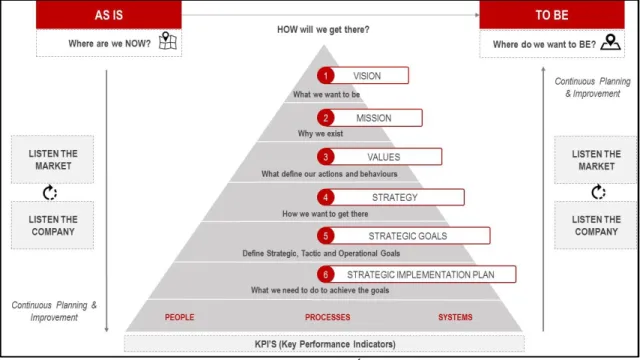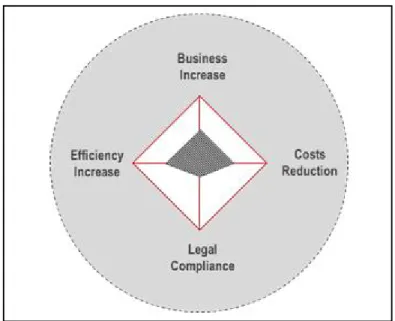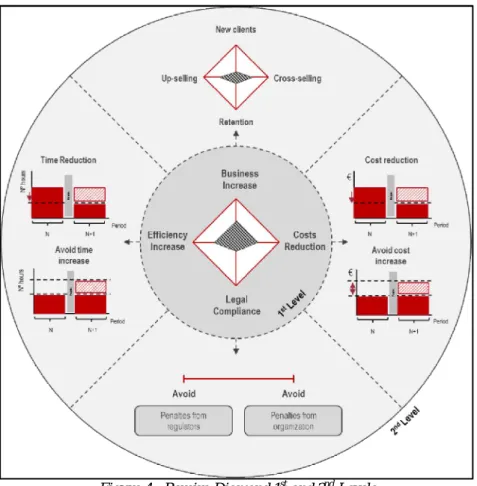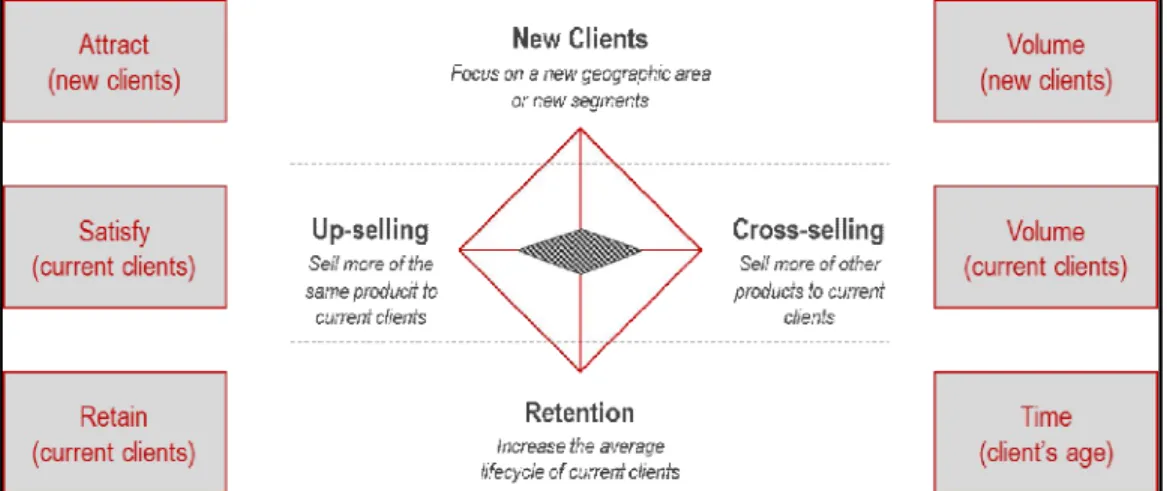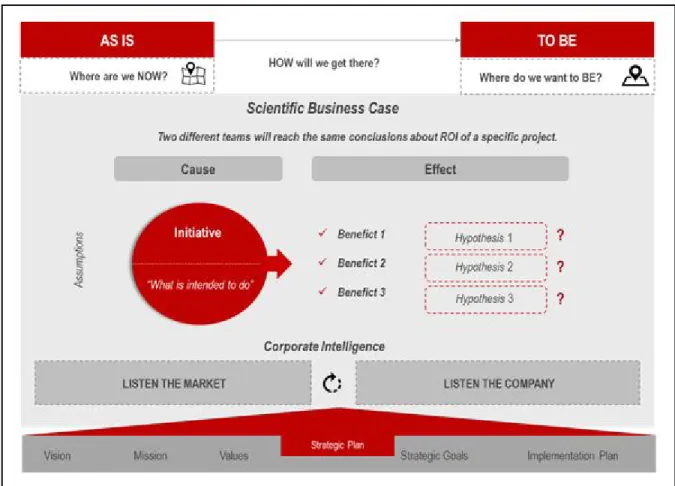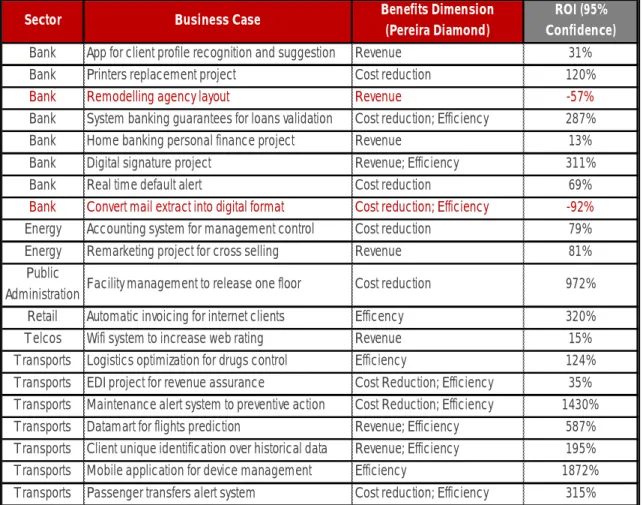47
Vol 3 Issue 3 March, 2015
THE INTERNATIONAL JOURNAL OF
BUSINESS & MANAGEMENT
Pereira Diamond: Benefits Management Framework
1. State-of-the-Art
1.1. The Competitive Market Context
Nowadays, the globalization, the power of technologies and the social networking have led to an aggressive market competition. Meanwhile, resources are getting scarce, such as financial, human resources and time, hence the urgent need to rationalize them to their utmost in order to, not only “survive” but grow in the current business world. There is no space for mistakes and no place for wastes. The tolerance for management error is getting tighter while their level of responsibility and accountability for decisions is increasing, daily. In order to be continuously capable of creating value, business managers are required to firstly have a clear organizational vision, mission and a well-defined business strategy combined with a set of portfolio regeneration towards converting strategic goals into business value. Figure 1 represents a strategic pyramid composed of relevant steps towards the integration and alignment from strategy to tactic and operational tasks and activities.
Claudia Sofia Bento Teixeira
Master’s Student, ISCTE Business School, Lisboa, Portugal Leandro Luis Ferreira Pereira
Professor, ISCTE Business School, Lisboa, Portugal Abstract:
Nowadays organizations are challenged daily to keep their business running by continuously adding value to its stakeholders in a sustainable way. In order to achieve that, business managers are required to have a clear organizational vision, mission and a well-established business strategy combined with a set of portfolio of projects towards converting strategic goals into business value. Although this is a clear concern in the most of management and executive teams, the majority of them are unable to identify the benefits each initiative will deliver neither how much they represent moneywise, easily leading to a complete “investment-in-failure”.
The crisis context together with the huge speed of technology advancements, the power of social networking and market globalization are triggering organizations to rationalize and optimize their resources while business managers are pressurized to deliver successful results. Another concern is the fact business managers are getting “tempted” to tighten their budgets and follow a cost-control management approach as it turns to be the most immediate way to get a positive impact on the P&L. However, in a long term, it will compromise the organization growth and the ability to create sustainable wealth to the stakeholders. This is where capital investments play a key role to support innovative initiatives’ implementation which explains the worldwide increase budget available for new investments, the capital expenditure (capex). But even though new project proposals justify the need of increasing funds, why do most of projects still fail on delivering results? Despite the well advanced project management techniques to manage projects efficiently (triple constraint criteria: scope, budget and time) are organizations selecting the most valuable projects? If resources are not infinite, organizations must follow a reliable appraisal model to select the initiatives that will deliver the most valuable return on investment. The ability to solve a market need with a high value for money within the time-to-market is essential, so knowing what, when and how to invest following a rigorous approach is becoming an essential business skill across every business sector. Since projects are investments which intend to maximize return then business cases and benefits management are a powerful tool to support top management decisions.
This paper presents the conceptual basis, perspectives and guidelines for effective project investments, based on the worldwide best practices for business cases. Besides the literature reviews and studies collected to date about this subject, the final conclusions presented are sustained on the results collected from a sample of companies across different sectors who were invited to participate on this research.
This research suggests that the Pereira Diamond approach to benefits management has a strong contribution to successful investment decisions towards the maximization of the return on investment hence the value creation to the business stakeholders.
48
Vol 3 Issue 3 March, 2015
Figure 1 : Strategic Piramid (Cláudia Teixeira, 2014)In the current aggressive competitive market, having the appropriate tools, resources and knowledge to make the right management decisions are key to any business success.
1.2. The State of the Art
Project success measurement is a subject which still requires a few improvements as the efficiency of the process (time / budget / scope) is still dominant rather than effectiveness of the project investment through organizational benefits generation (O. Zwikael and J. Smyrk, 2012). This means project definitions and methodologies in place still ignore a relevant dimension, the generation and realization of benefits during the project management cycle. (Müller and Turner, 2007). The project management professionals andrelated literature is still very focused on project deliveries which ends up neglecting the projects’ intended benefits (Ashurst, Doherty and Peppard, 2008).
Although there are advancements on project management techniques to assist in managing projects efficiently are organizations selecting the most effective projects? If resources are not infinite, organizations need a reliable appraisal model to select the initiatives that will deliver the most valuable return on investment.
1.3. The Business Case Role
In the current fast-paced world of business just a few organizations create business cases or present a cost-benefit analysis when analyzing a potential investment.
However, are organizations using it in the right terms and process? Are they involving the right stakeholders? Are they using reliable data with the appropriate tools and techniques? Is there any monitoring plan during the Business Case implementation and an ex post-evaluation? Is top management well aware about the expected return on investment? Are the stakeholders involved accountable, responsible and liable for the information provided?
While very often business cases are based on unreliable data and subjective assumptions, they are commonly used with the goal of securing resources and funding and once the projects get implemented the creation of value is seriously compromised. In fact, taking the wrong decisions end up destroying value, either because the actual amount of investment and new operational costs (opex) were higher than previously estimated or when benefits estimated were over optimistic or both simultaneously. Very often, decision makers also easily fall to resist to the powerful forces that drive them to the desired answer. Most organizations are struggling to follow a clear process and collect reliable data in order to estimate the benefits leveraged by a new investment. For a successful business case it is critical that the logic and numbers stand up and provide a clear evidence of facts avoiding any twist of the projected reality. The business case should result on the best projected future results and not based on a subjective and irrational expectation or desire. An effective business case assists the management team in evaluating whether a specific investment will contribute to achieve a business need, hence the relevance of the benefits’ rationale playing an important role into the business case which impacts (benefits) are measured in financial terms (Schmidt, 2009).
According to BABOK (Business Analysis Body of Knowledge, a globally recognized standard for the practice of business analysis), a business need may come from four origins:
1. Top down – a need to achieve a strategic goal
49
Vol 3 Issue 3 March, 2015
3. Middle Management – a manager needs more information to support their decisions or needs new functionalities to achieve the business needs
4. External Sources – due to third parties, legal compliance or market competition
Once the business needs are identified,the business case becomes helpful on providing insightful data on which solutions proposed will better suit the problem, need or opportunity reported and consequently support top management decisions on knowing what, how and when to invest resources towards maximizing business value.
1.4. Statistics and Other Studies
Although the benefits management is still a topic under development, some professionals have already found interest to pursue some studies on how much organizations care and apply the benefits rationale as a main driver for projects selection and management. The results from a national (UK) survey conducted by APM (Association for Project Management) shows the strong evidence ofa cost control management culture in the organizations surveyed: 54% of respondents indicated that cost reduction is a primary driver of projects and programmes in their organisation (Glynne, Peter,& Williams, Rod (2009). Although becoming cost effective is a current concern and a starting point, on a long term the company may start compromising the business if the main focus is on costs reduction. According to John Kotter’s article at the Harvard Business Review, Professor of Leadership at Harvard Business School in Boston, “Up to 70% of change initiatives fail to deliver on the benefits that they set out to achieve”. Kotter, emphasizes that realising benefits cannot be the responsibility of only the project or programme manager but instead, it needs to be a partnership approach between the managers delivering change and those in ‘business as usual’ (Kotter, 1995). He reminds that often “when a programme closes, the changes are still being embedded and significant benefits are yet to be realised” (Kotter, 1995)
A more recent study conducted in September 2014 by APM Benefits Management SIG (Specific Interest Group) undertook a questionnaire survey to find out how benefits management is viewed in the organisations that its members work for. The respondents were almost all based in the UK and worked in a wide spread of industrial sectors.One of the questions was: “By widening the focus to the whole organization, to what extent is benefits thinking integral to the wider approach to management, from strategy to operations?” to which 40.5% answered it is “weak benefits focus” plus 23.8% as a “very weak benefits focus”. The survey also suggests “there is a need for guidance and best practice examples on how benefits management might fit within the overall approach to organisational change and project/programme/portfolio management (APM, 2014)”. The authors also noted that while considering different nature of businesses (different types of organisations and industrial sectors), benefits practices cannot be a “one size fits all” approach, but instead needs to be tailored to different contexts.
The founder of ROI Institute, Phillips expresses the increasing need on key executives becoming aware of their projects’ ROI: “The use of the ROI Methodology has intensified during this global recession, as organizations of all types have used this methodology to decide which programs to eliminate, which to keep and which to fund in the future. (…) As more organizations come out of the recession, key executives are demanding ROI up front, before a project is implemented. Because there is a need to avoid wasteful spending and unnecessary expenses to keep the organization lean, executives are asking for a forecast of ROI in advance”(Phillips, 2011).
Although there is recognition on the need of benefits management there are still a little action and desire to actively pursue and embed a benefits management culture.
2. Research Methodology
In order to validate Pereira Diamond’s conceptual model effectiveness, several companies across different sectors were asked to apply the suggested model over some of their initiatives appraisal. After assisting them and validating that the process was followed, it was requested to each of them the final ROI (return on investment) achieved at the end of the project exploitation. As projects may have different lifecycles periods, it was required to the participants to consider initiatives up to 2 years.
A call for participation in the study was done to invite the professionals responsible for this subject or with high level of involvement in these tasks within their organization located in Portugal. Of the50 invitations to participate on this research, we received a total of 22 respondents (44%), from 6 different sectors. Out of the responses received, 7 were from Transports, 8 from Banks, 1 from Telecommunications, 2 from Energy, 1 from Retail and 1 from Public Administration sectors.
3. Conceptual Model: Pereira Diamond
3.1. The Benefits Rationale and the Four Benefits Dimensions
Facing a context where resources are scarce and unpredictable constrains, companies ought to decide as to which investments they should invest that maximize the most business value. If organizations are currently living in a competitive market where customers’ needs are continually changing, then the ability to manage the internal resources (employees), “listen” to the market and convert that valuable information into innovative projects are key to keep creating value to customers and wealth for organizations. This is where the analysis of new initiatives through business cases, becomes an essential vehicle to assist top management converting the company strategy into execution. Why? Because to foster business growth, energize employees and attract new customers continuously, companies need to invest– invest the resources in the projects that will bring positive results and generate wealth to the business. This is where Business Cases practices based on scientific management have a crucial role on the decision-making process.
50
Vol 3 Issue 3 March, 2015
In order to follow a rational, objective and impartial process, the Business Case should follow a scientific management principle towards the end goal of getting two different people reaching the same or very similar results’ estimation, when analysing under the same circumstances / conditions.
Investments have to be more predictable, avoiding deviations to scope, budget and time frame, otherwise organizations will keep facing the risk of not creating value to the organization. Furthermore, this requirement is also reflected in a higher value for money, seeking to extract the maximum value from investments, otherwise the opportunity cost will be extremely high. Learning on how to invest in the right projects is synonymous to organizational regeneration towards prosperity.
Considering that any business manager mission is to maximize wealth and continuously create added value, organizations have to start from defining projects’ benefits, rather than looking exclusively for the financial value. A project’s origin within an organization, is bounded by the four dimensions presented. Pereira Diamond Model presents these four dimensions as the primary causes for a project “birth”. But firstly, in order to identify the according dimensions, it is important to bear in mind the principle of the value of something, which is measured by the impact of having something or not having or losing it. Figure 3 shows of how the perception of value changes according to having or not having something:
Figure 2: The Value of Something
In other words "the value of something" is measured by the impact it generates and its effect upon implementation, and not by the financial cost implied itself.
Having the value of something principle clear, a project proposal may be classified over one of the four dimensions according to the major benefit contribution: business increase, efficiency increase, costs reduction or legal compliance.
The image below presents the four types of benefits an initiative may have:
Figure 3: Pereira Diamond, 1st Level
When conducting a business case to evaluate a project viability, the estimation should be based on the economic value generated and not on a financial perspective (eg. Liquidity level; Repayment schedule of external financing over the years, depreciations; etc ...). So, the economic value added by an initiative is not measured by the cost involved but instead, by the economic impact generated, hence the importance ofthe understanding the principle of the value of things (figure 3) during the benefits identification and estimation process.
51
Vol 3 Issue 3 March, 2015
In order to instantiate and organize the initiative’s benefits under consideration, each of these dimensions can consider different scenarios depending on the problem that will resolve or mitigate.
The following image (Figure 4) illustrates the second level of benefits within each dimension:
Figure 4: Pereira Diamond 1st and 2nd Levels 3.1.1. Business Increase
If a project’s ambition is to increase business, then the project is connected to the “outside” (market). A project within this dimension, its inherent goal is to increase the company's results, on the revenue side, through:
A. Increase market share by portfolio diversification or new geographic areas (product development or market development, respectively). It aims to increase sales volume by attracting new customers.
B. Increase cross-selling (selling more of other products/service to current customers). It aims to increase sales volume through the satisfaction of current customers.
C. Increase up-selling (selling more of the same product/service to current customers). It aims to increase sales volume through the satisfaction of current customers.
D. Increase customer loyalty (increase customer life cycle). It aims to increase the time the customer stays in the company by retaining them for longer, ie avoiding disruption of the relationship.
52
Vol 3 Issue 3 March, 2015
Figure 5: Pereira Diamond: Business Increase Dimension3.1.2. Costs Reduction
In the costs reduction dimension, the main initiative’s goal is to obtain an effective decrease in the expenses (costs) account of the company. This costs decrease is reflected on a financial reduction, and not on teams’ hours of work (effort), unlike projects classified on the efficiency dimension.
As a benefit, the costs reduction is quantified by the amount of the cost decreased in the existing organization or by the cost avoided in the future as a result of this initiative implementation. In order to determine the benefit, it is only required to identify the costs in the current process and the costs likely to be eliminated, while bringing impacts in a short-term period.
Figure 6: Pereira Diamond: Costs Reduction 3.1.3. Efficiency Increase
The projects within the efficiency dimension do not have an economic or financial implication, such as a direct impact on the company expenses (costs) account. They do instead, have an impact on human abilities by optimizing processes which release time. The benefits quantification in this dimension are based on reducing the time of a particular process or in projects that will prevent a future increase in the time of a process. Once the process or task has reduced its time of execution, resources can be released or mobilized to another process.
Figure 7: Pereira Diamond: Efficiency Increase 3.1.4. Legal Compliance
Projects under the legal compliance dimension are projects that seek to comply with the regulators entities and/or policy group instructions. Once these initiatives are mandatory, projects usually move forward without the requirement of prior benefits quantification.
53
Vol 3 Issue 3 March, 2015
Figure 8: Pereira Diamond: Legal Compliance3.2. The Difference between the Primitive Benefits and Instantiated Benefits
In order to turn benefits into quantifiable results, firstly it is required to instantiate them. It is not goodenough to say that the project will reduce customer dissatisfaction since “reducing dissatisfaction” by itself cannot be “converted” moneywise. This is a benefit on a primitive status and for that reason must be transformed into an instantiated benefit, for example, increasing the costumer life cycle in the company through a better customer relationship. While the reduction in customer dissatisfaction does not allow to make a conclusion on the value added, after specifying it as ”increasing the client life cycle” it will become able to be quantified.
To sum up, during the benefits identification and quantification process it is not intended to obtain the cause of the benefit but instead, the final effect in economic terms levered to the organization. Table1 presents a few examples of how the benefit effect should be defined for further quantification.
Table 1: Example: Primitive Benefits vs. Instantiated Benefits
Based on the Pareto principle, the estimated return on investment should consider 20% of the main benefits generated (ideally up to 3 benefits), since they represent 80% of the value generated. The remaining identified benefits should be classified as intangible for its residual weight and for its small contribution taken in the final decision upon deciding whether to go ahead or not with the initiative implementation.
It is recommended to identify up to three main benefits based on the principle of Pareto Law. “Vilfredo Pareto was an Italian economist and sociologist (1848-1923) who demonstrated that 80 per cent of the wealth of the nation was distributed among 20 per cent of the population ("the vital few"). The remaining 20 per cent of the wealth was distributed among the other 80 per cent of the population ("the trivial many") (La Rooy, 1999).” Pareto’s theory became known as the “80/20” rule, which states that 20% of the known variables will account 80% of the results. (Basile, 1996), which was the result of the observations and writings of Joseph M. Juran, a "pioneer in the development of principles and methods for managing quality control programs" (Juran, 2001). Juran admitted that the linkage of the principle with Pareto was wrong and "gave the name 'Pareto' to this principle of the `vital few and trivial many' which is a shorthand name for the phenomenon that in any population which contributes to a common effect, a relative few of the contributors account for the bulk of the effect" (Juran, 2001).
Since then, the Pareto principle has become generally accepted in management sciences. According to Juran (1954), he stated that the principle is a "universal" for planning and controlling and Drucker (1996) in essence also confirmed the importance of the "vital few" by noting that effective executives do not make a great many decisions. They concentrate on the important ones" (Drucker, 1996).
54
Vol 3 Issue 3 March, 2015
3.3. Pereira Diamond Approach within the Business Case ProcessThe process of preparing a Business Case should follow a methodology complemented by a set of tools and techniques in order to analyse whether an investment will create value to the organizations.
Based on the business case practices developed by different authors, the overall business case steps and benefits mindset may be synthesized on the following steps:
1. Ability to listen to the market continuously– teams needs to have the ability to understand the market, consumers needs and the competitive environment
2. Executive Team to establish a future vision and have a strategic plan clearly defined as it is the starting point to conduct any business. Decompose the strategic plan into strategic goals throughout the organization pyramid (from operational team to top management)
3. Convert that strategies and goals to valuable projects (set a projects portfolio following the benefits rationale)
4. Analyse the purpose of the new initiative, whether it is a business opportunity, problem or need. This is one of the most important steps in the process. This is where the business case will be based on, so it must be clearly described and understood
5. Analyse its alignment to the mission, vision and strategic plan
6. Determine the solution benefits, according to the four dimensions (stated in Pereira Diamond model) 7. Determine the solution costs and capture economic results
8. Analyse stakeholders and define a communication plan 9. Make a recommendation and a decision-making: GO/NO-GO 10. Benefits tracking and monitoring
Figure 10 : Scientific Business Case
All the steps are equally important, however the benefits estimation ones are critical as they will be the results determining whether a potential project will create value to the organization and whether it should be implemented or not.Pereira Diamond approach facilitates the analysis when assessing which types of benefits are estimated by the solution proposed and find the correct equation to quantify future benefits.
55
Vol 3 Issue 3 March, 2015
4. Data AnalysisIn order to validate whether Pereira Diamond conceptual’ s model contributes to a successful ROI, we have invited a group of companies across different sectors who have followed this model when preparing their business cases and selecting the projects portfolio. Table 1 presents the ROI realized in each company together with the project name and benefits dimensions which classifies the type of project within the four dimensions presented in Pereira Diamond.
From the overall invitations to participate on this research, we received a total of 22 respondents from 6 different sectors: 7 were from Transports, 8 from Banks, 1 from Telecommunications, 2 from Energy, 1 from Retail and 1 from Public Administration sectors.
Table 2 : ROI Realization
It is possible to conclude that only 2 out of 22 projects were unsuccessful based on the negative ROI achieved, representing 9% of the overall projects under research.
5. Conclusion
In summary, although organizations are experiencing difficult times to stay competitive in the market and being highly pressured to rationalize resources, only a very few practice a benefits management mind-set when making their management decisions. Despite the challenging times, a business manager must bear in mind that its first mission is creating wealth to the business and stakeholders, so his/her decisions should always have this goal in mind, instead of only putting energy and effort on a cost control measures.
Since the business need may come from different possible origins, either top down, bottom-up, middle management or even due to external sources, it is essential that a benefits mind-set is “educated” across the teams so they clearly understand the value of their innovative contributions and initiative proposals. Once the business needs are identified, the business case becomes helpful on providing insightful data on which solutions proposed will better suit the problem, need or opportunity reported and consequently support top management decisions on knowing what, how and when to invest resources towards maximizing business value.
The conceptual model and principles proposed by Pereira Diamond have been applied in some organizations resulting in very positive return on investments. The project management professionals involved managed the project efficiently (budget, time and scope) however it is important to highlight that if the projects wouldn’t have been correctly analysed (business case) and selected it could have been a complete failure with huge impacts on the company results.
Although organizations start having more awareness on this subject, just a very few have implemented a methodology and the best practices when pursuing initiatives appraisals (business cases) and selecting project portfolios. As proven in the research, if organizations start following a Pereira Diamond approach in every initiative analysis and decision-making process, they will be able to
Sector Business Case Benefits Dimension (Pereira Diamond)
ROI (95% Confidence)
Bank App for client profile recognition and suggestion Revenue 31%
Bank Printers replacement project Cost reduction 120%
Bank Remodelling agency layout Revenue -57%
Bank System banking guarantees for loans validation Cost reduction; Efficiency 287%
Bank Home banking personal finance project Revenue 13%
Bank Digital signature project Revenue; Efficiency 311%
Bank Real time default alert Cost reduction 69%
Bank Convert mail extract into digital format Cost reduction; Efficiency -92%
Energy Accounting system for management control Cost reduction 79%
Energy Remarketing project for cross selling Revenue 81%
Public
Administration Facility management to release one floor Cost reduction 972%
Retail Automatic invoicing for internet clients Efficency 320%
T elcos Wifi system to increase web rating Revenue 15%
T ransports Logistics optimization for drugs control Efficiency 124% T ransports EDI project for revenue assurance Cost Reduction; Efficiency 35% T ransports Maintenance alert system to preventive action Cost Reduction; Efficiency 1430% T ransports Datamart for flights prediction Revenue; Efficiency 587% T ransports Client unique identification over historical data Revenue; Efficiency 195% T ransports Mobile application for device management Efficiency 1872% T ransports Passenger transfers alert system Cost reduction; Efficiency 315%
56
Vol 3 Issue 3 March, 2015
make more rational, objective and valuable decisions. If organizations aim to succeed, it is a priority to understand the value of making effective projects (the right projects) and secondly managing them efficiently (managing them right). The benefits rationale should work as a main driver for budgeting definition and especially for projects selection which should become an overall mindset across the organizations’ teams (from strategic to tactic and operational teams). Learning on how to invest in the right projects with the best value for money in the right time to market is synonymous to organizational regeneration towards prosperity.
6. References
1. Ashurst, C., N. F. Doherty and J. Peppard 2008. Improving the impact of IT development projects: the benefits realization capability model, European Journal of Information Systems, 17: 352–370
2. Basile, F 1996. Great management ideas can work for you. Indianapolis Business Journal 16: 53-54. 3. Drucker, P. 1996. The Effective Executive, Harper and Row. New York, NY: 116.
4. Glynne, Peter,& Williams, Rod 2009. A strategic business skill for all reasons. Association for project managers. Published on July 2010
5. Juran, J. 2001. The non-Pareto principle; mea culpa. Retrieved from The Juran Institute: www.juran.com/research/articles/ sp7515.html. Consulted on September 2014
6. Kotter, J. 1995. Leading Change Why Transformation Efforts Fail. Harvard Press Review. 7. La Rooy, G. 1999. Know what counts. NZ Business, 13: 28-31.
8. Müller, R. and R. Turner 2007. The influence of project managers on project success criteria and project success by type of project, European Management Journal, 25: 298–309.
9. O. Zwikael and J. Smyrk 2012. A General Framework for Gauging the Performance of Initiatives to Enhance Organizational Value, British Journal of Management, 23: 6–22
10. Pereira, L.(2014). Como Criar Riqueza. Bnomics.
11. Phillips, J. 2011. Questions about ROI in today's climate. Magazine HR Poland: ROI Institute publications and articles 12. Schmidt, M. J. 2009. Business Case Essentials, A Guide to Structure and Content. Boston: Solution Matrix ltd.
13. Serra, C. E. M., 2012. ‘Benefits Realisation Management and its influence on project success, project governance, and execution of business strategy - Analysis of Brazil, the United Kingdom, and the United States of America’. Working Paper, University of Warwick. Coventry, UK.
